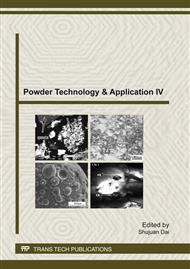p.285
p.292
p.299
p.305
p.310
p.315
p.320
p.324
p.329
Study on Deep Reduction and Efficient Separation of Lingyang Iron Ore
Abstract:
The test for deep reduction and efficient separation of Lingyang iron ore from Linjiang that cannot be separated and utilized by any conventional mineral processing technology was conducted in the Laboratory, and the research results showed that iron from Lingyang iron ore was recovered effectively. In this paper, the effect of reduction temperature, time and coal content on reduction was analyzed, and the process of deep reduction and efficient magnetic separation was investigated. Furthermore, on such optimum conditions of deep reduction as reduction temperature 1275°C, time 50min, and coal content 40%, the reduction products were separated in the flowsheets of magnetic separation after fine grinding and the iron powder products with iron grade 79.58% and recovery 62.77% were obtained.
Info:
Periodical:
Pages:
310-314
Citation:
Online since:
January 2012
Authors:
Keywords:
Price:
Сopyright:
© 2012 Trans Tech Publications Ltd. All Rights Reserved
Share:
Citation:


